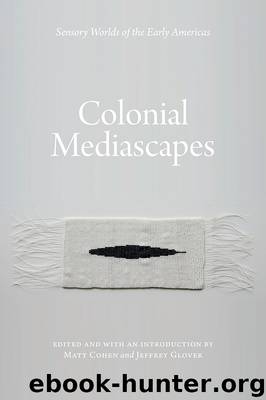Colonial Mediascapes by Matt Cohen

Author:Matt Cohen [Matt Cohen]
Language: eng
Format: epub
Tags: Social Science
ISBN: 9780803232396
Publisher: University of Nebraska Press
Published: 2014-01-28T00:11:00+00:00
9.
Hearing Wampum
The Senses, Mediation, and the Limits of Analogy
Richard Cullen Rath
In 1756, Virginia citizens were feeling anxious and vulnerable to the threat of the Catawbas and Cherokees joining the French in the war against the English. Relations with the Indians were already strained on a number of fronts. Catawbas had successfully played internal colonial interests off against each other, so that Virginia had only recently been vying with South Carolina and North Carolina for their loyalties. Virginia had also skipped the unsuccessful Albany Conference, but it had been no more successful in its independent negotiations. With the French and Indian War looming large in their thoughts, the Virginians were now anxious to shore things up with the Catawbas and Cherokees, so they sent messengers to both nations to set up treaty councils.1
The Virginia delegation had prepared for Catawba protocols as best they could. They had difficulties obtaining enough wampum to make the treaty hold. They decided to try to be frugal with it in the hopes that more would be brought, but in the meantime they had to substitute other presents for the usual number of belts and strings of the patterned beads made from seashells.2 Wampum was central to treaty negotiations. It made sounds significant and impressed those sounds upon the minds of those present.
For their part, the Virginians began the negotiations by reading their commissions aloud, thus verbally establishing their legitimacy to be speaking for the whole of the colony. Lieutenant Governor Robert Dinwiddie’s instructions concerning his speech reveal interesting notions about Catawba and Virginian beliefs about where sounds came from. He told the commissioners, “(as the Custom of the Indians is) you are to tell them their Brother, the Governor of Virginia, is going to speak to them.” The commissioners then read aloud a speech that Dinwiddie had written and marked it by presenting a belt of wampum to the Catawbas.3 The idea that one person’s or a group’s speech could come from the mouth of another, a form of ventriloquism perhaps, is a sonic trait that distinguishes indigenous soundways from Anglo-American ones and seems always to have been marked by a present of wampum.
The speeches that followed were carefully framed, but in the discourse of the Catawbas rather than the Virginians. Treaty councils were gendered, age-differentiated spaces, with women and children generally excluded and elders speaking first, perhaps followed by some of the younger warriors. Each statement or proposition was accompanied by a string or belt of wampum, hides, or some other item presented to the listening party. This held for both sides of the negotiations, not just for the indigenous nations. When one side or the other had finished its speeches, the Virginians wrote down their records while the Catawbas entered the speeches into their official record with the wampum that the Virginians presented and a loud shout that the Virginians called the “Yo-Hah.”
The sounds that the Virginians and Catawbas made and the wampum they presented each other were in some respects as important as their words.
Download
This site does not store any files on its server. We only index and link to content provided by other sites. Please contact the content providers to delete copyright contents if any and email us, we'll remove relevant links or contents immediately.
| African-American Studies | Asian American Studies |
| Disabled | Ethnic Studies |
| Hispanic American Studies | LGBT |
| Minority Studies | Native American Studies |
Cecilia; Or, Memoirs of an Heiress — Volume 1 by Fanny Burney(31438)
Cecilia; Or, Memoirs of an Heiress — Volume 3 by Fanny Burney(31030)
Cecilia; Or, Memoirs of an Heiress — Volume 2 by Fanny Burney(30978)
The Great Music City by Andrea Baker(22614)
We're Going to Need More Wine by Gabrielle Union(18119)
Bombshells: Glamour Girls of a Lifetime by Sullivan Steve(13153)
Pimp by Iceberg Slim(12984)
All the Missing Girls by Megan Miranda(12825)
Fifty Shades Freed by E L James(12487)
Talking to Strangers by Malcolm Gladwell(11971)
Norse Mythology by Gaiman Neil(11952)
Crazy Rich Asians by Kevin Kwan(8406)
Mindhunter: Inside the FBI's Elite Serial Crime Unit by John E. Douglas & Mark Olshaker(7886)
The Lost Art of Listening by Michael P. Nichols(6525)
Enlightenment Now: The Case for Reason, Science, Humanism, and Progress by Steven Pinker(6442)
Bad Blood by John Carreyrou(5810)
The Four Agreements by Don Miguel Ruiz(5568)
Weapons of Math Destruction by Cathy O'Neil(5091)
We Need to Talk by Celeste Headlee(4916)
